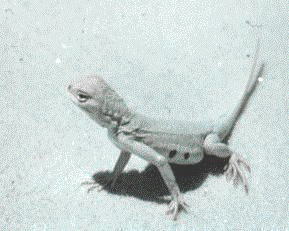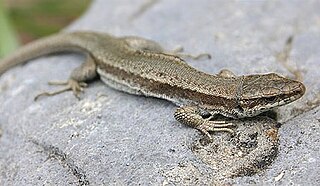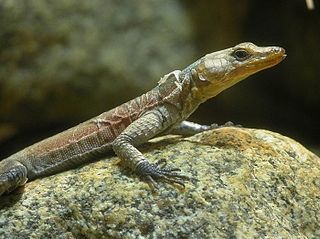
Bunopus is a genus of small geckos, lizards in the family Gekkonidae. The genus is endemic to the Middle East.

The California rock lizards are a genus (Petrosaurus) of New World lizards in the family Phrynosomatidae.

The genus Cordylus includes a wide variety of small- to medium-sized spiny lizards from Africa, collectively called girdle-tailed or girdled lizards. All are diurnal and ovoviviparous. Most species are rupicolous (rock-dwelling), while a few species are arboreal or live in burrows. They defend themselves with osteoderms and by quickly retreating into rock crevices or burrows. Many species live in groups and males defend territories.

Darevskia is a genus of wall lizards of the family Lacertidae. It includes 34 species, 28 of which are found in northern Eurasia.

Lacerta is a genus of lizards of the family Lacertidae.

Holbrookia is a genus of earless lizards, known commonly as the lesser earless lizards, in the family Phrynosomatidae. The genus contains five recognized species, which are found throughout the southwestern and central United States and northern Mexico. They are characterized by having no external ear openings, presumably to prevent sand from entering their bodies when they are digging.

Night lizards are a group of small scincomorph lizards, averaging from less than 4 cm to over 12 cm snout-vent length. Most species are viviparous (live-bearing), with the exception of those in the genus Cricosaura. The family has only three living genera, with approximately 34 living species. The genera are divided by geographic range: Xantusia in southwestern North America and Baja California, Cricosaura in Cuba, and Lepidophyma, the most populous night lizard genus, in Central America. Three fossil genera are also known: Catactegenys, Palepidophyma, Palaeoxantusia.

The Agaminae are a subfamily of reptiles in the family Agamidae.

The Pyrenean rock lizard is a species of lizards in the family Lacertidae. It is endemic to the Pyrenees where it occurs at high altitudes and is only active in summer.

The Mosor rock lizard is a species of lizard in the Lacertidae family. It is found in Bosnia and Herzegovina, Croatia, Serbia, and Montenegro. Its natural habitats are boreal forests, temperate forests, temperate shrubland, and rocky areas. It is threatened by habitat loss.
Mitchell's flat lizard is a species of lizards in the family Cordylidae.

The Sekukhune flat lizard is a species of lizard in the family Cordylidae. The species is endemic to South Africa. It has two subspecies.

The Pungwe flat lizard is a species of lizard in the Cordylidae family.

The East African spiny-tailed lizard, also commonly known as the dwarf sungazer or the tropical girdled lizard, is a species of arboreal or rupicolous (rock-dwelling) lizard endemic to East Africa.

The Kimberley rock monitor is a medium-sized species of monitor lizard in the family Varanidae. The species is native to Northern Australia. Also known as Glauert's monitor or the Kakadu sand goanna, it belongs to the subgenus Odatria.
Juraj Kolombatović was a Croatian zoologist, best known for his work in the field of ichthyology and the Marjan hill reforestation project.














